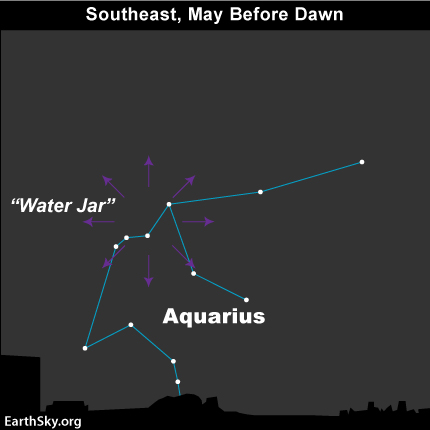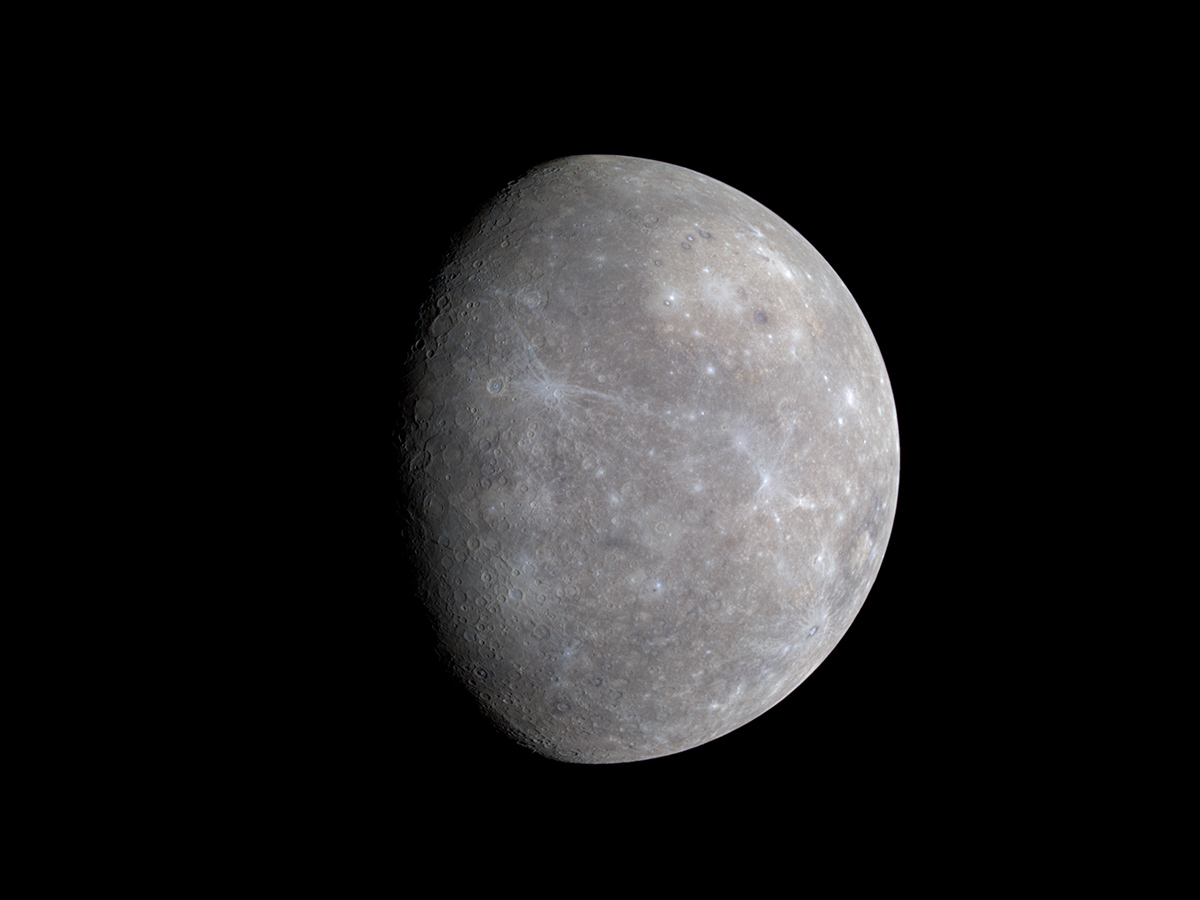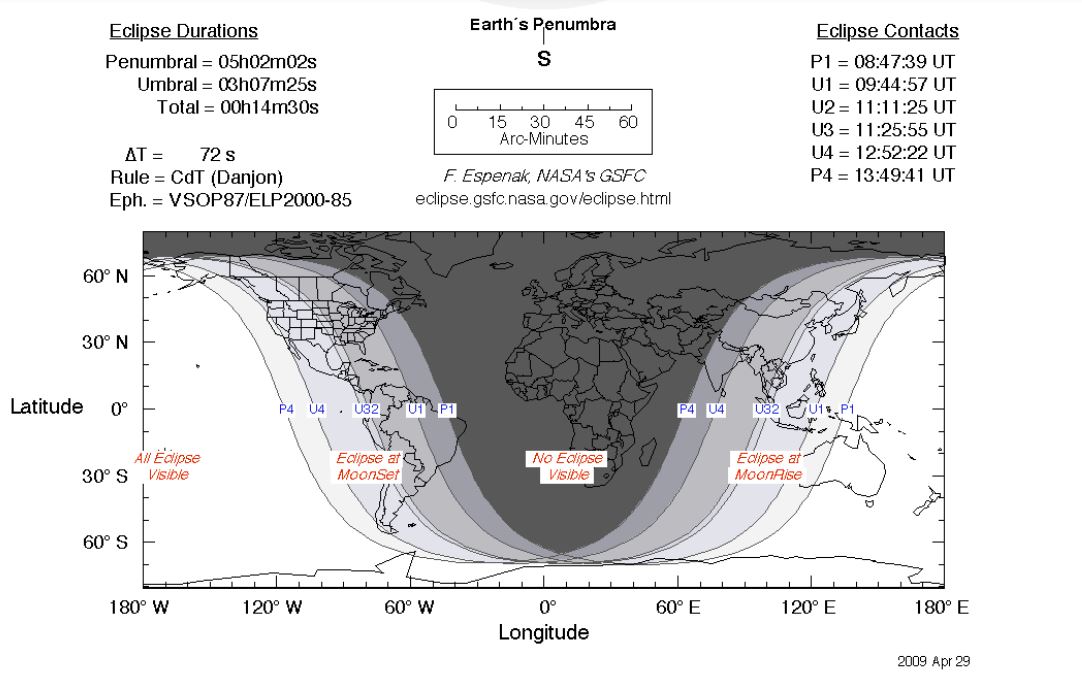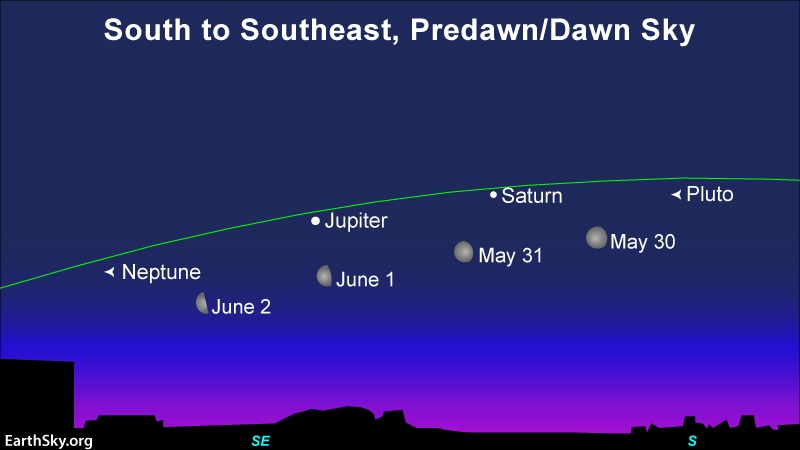What to Look for in the Night Sky: May 2021
Special Stories
14 Apr 2021 2:30 AM
Time to dust off the binoculars and lawn chairs, it's nearly prime star gazing season! As pleasant overnight temperatures become more consistent across the lower 48 during the month of May, head outside to enjoy several worthy night sky events - including a meteor shower and a total lunar eclipse. Just don't forget the bug spray if you're in the Deep South.
Spotting the International Space Station is always a great activity and is easy to do thanks to this handy tool. For even more events to look for in the night sky, check out the "tonight" feature on the EarthSky website.
 Aquarius will be visible near the southeastern horizon from the Northern Hemisphere. Credit: EarthSky
The Eta Aquarids are a decent shower for many in the Northern Hemisphere, though they put on a better show for those near and south of the equator.
If you live in the lower 48, you may be able to muster about 20-30 meteors per hour during the shower's broad peak, which is centered on the morning of May 5th. The meteors will appear to radiate from Aquarius, but look at as much of the southern sky as possible to catch more meteors. The waning moon may prevent some of the more faint meteors from being seen. If there's a clear night where you live around the week of the peak, look to the south before dawn to try to catch a glimpse at some of the dust and particles left behind by Halley's Comet.
Aquarius will be visible near the southeastern horizon from the Northern Hemisphere. Credit: EarthSky
The Eta Aquarids are a decent shower for many in the Northern Hemisphere, though they put on a better show for those near and south of the equator.
If you live in the lower 48, you may be able to muster about 20-30 meteors per hour during the shower's broad peak, which is centered on the morning of May 5th. The meteors will appear to radiate from Aquarius, but look at as much of the southern sky as possible to catch more meteors. The waning moon may prevent some of the more faint meteors from being seen. If there's a clear night where you live around the week of the peak, look to the south before dawn to try to catch a glimpse at some of the dust and particles left behind by Halley's Comet.
 Image credit: NASA
Greatest elongation! What in the heliosphere does that mean? That means Mercury will be at a positive angle relative to the sun to be viewed from Earth. Still don't get it? Mercury is going to be bright and (somewhat) easy to find during the month of May.
If you want to spot the closest planet to the sun, look to the west just after sunset. You'll probably be able to find Venus fairly easily since it's so dang bright (think morning star, but in this case it's in the evening). Once you've found Venus, Mercury should appear just above and slightly to the west. If you're having trouble spotting it, try to get away from any bright lights and use binoculars or a telescope.
Image credit: NASA
Greatest elongation! What in the heliosphere does that mean? That means Mercury will be at a positive angle relative to the sun to be viewed from Earth. Still don't get it? Mercury is going to be bright and (somewhat) easy to find during the month of May.
If you want to spot the closest planet to the sun, look to the west just after sunset. You'll probably be able to find Venus fairly easily since it's so dang bright (think morning star, but in this case it's in the evening). Once you've found Venus, Mercury should appear just above and slightly to the west. If you're having trouble spotting it, try to get away from any bright lights and use binoculars or a telescope.
 Image credit: NASA/Bill Ingalls
Let's get this out of the way first: If you live on or near the East Coast of the United States, you aren't going to be able to see much, if any, of this lunar eclipse. If you live near the sub-tropics on the East Coast, such as South Florida, you'll be able to see the partial eclipse begin just a bit before the moon sets. That doesn't mean you shouldn't go check out the moon on this night, since it will be the biggest of the year (did someone say supermoon?) as the moon will be nearing its closest point to Earth in its orbit.
Image credit: NASA/Bill Ingalls
Let's get this out of the way first: If you live on or near the East Coast of the United States, you aren't going to be able to see much, if any, of this lunar eclipse. If you live near the sub-tropics on the East Coast, such as South Florida, you'll be able to see the partial eclipse begin just a bit before the moon sets. That doesn't mean you shouldn't go check out the moon on this night, since it will be the biggest of the year (did someone say supermoon?) as the moon will be nearing its closest point to Earth in its orbit.
 If you're lucky enough to live in the Mountain or Pacific Time Zone, you'll get to see the total lunar eclipse just before or about an hour before sunrise. Look to the west to spot the red moon. Totality will only last about 15 minutes and starts around 5:11 am MT/4:11 am PT.
If you're lucky enough to live in the Mountain or Pacific Time Zone, you'll get to see the total lunar eclipse just before or about an hour before sunrise. Look to the west to spot the red moon. Totality will only last about 15 minutes and starts around 5:11 am MT/4:11 am PT.
 Image credit: EarthSky
This one doesn't need much of an explanation, but it's still pretty neat! Look to the Southeast during the dawn and pre-dawn hours during the last few days of May and early June to see the waning Moon appear to pass close to the solar system's two largest planets. If you're in a dark sky location, the center of the Milky Way should be visible as well.
This should make for a fantastic photo opportunity if you have a camera that can take long exposures. Crank up the ISO, set the aperture to a higher value (11+ should work well), and leave the lens open for a good 15-20 seconds. You should be able to catch the Moon, the biggest planets, and the Milky Way in one frame. The moon will probably wash out some of the finer details of our galaxy, but it should still produce an excellent visual.
Image credit: EarthSky
This one doesn't need much of an explanation, but it's still pretty neat! Look to the Southeast during the dawn and pre-dawn hours during the last few days of May and early June to see the waning Moon appear to pass close to the solar system's two largest planets. If you're in a dark sky location, the center of the Milky Way should be visible as well.
This should make for a fantastic photo opportunity if you have a camera that can take long exposures. Crank up the ISO, set the aperture to a higher value (11+ should work well), and leave the lens open for a good 15-20 seconds. You should be able to catch the Moon, the biggest planets, and the Milky Way in one frame. The moon will probably wash out some of the finer details of our galaxy, but it should still produce an excellent visual.
May 6th/7th: Eta Aquarids Meteor Shower
 Aquarius will be visible near the southeastern horizon from the Northern Hemisphere. Credit: EarthSky
The Eta Aquarids are a decent shower for many in the Northern Hemisphere, though they put on a better show for those near and south of the equator.
If you live in the lower 48, you may be able to muster about 20-30 meteors per hour during the shower's broad peak, which is centered on the morning of May 5th. The meteors will appear to radiate from Aquarius, but look at as much of the southern sky as possible to catch more meteors. The waning moon may prevent some of the more faint meteors from being seen. If there's a clear night where you live around the week of the peak, look to the south before dawn to try to catch a glimpse at some of the dust and particles left behind by Halley's Comet.
Aquarius will be visible near the southeastern horizon from the Northern Hemisphere. Credit: EarthSky
The Eta Aquarids are a decent shower for many in the Northern Hemisphere, though they put on a better show for those near and south of the equator.
If you live in the lower 48, you may be able to muster about 20-30 meteors per hour during the shower's broad peak, which is centered on the morning of May 5th. The meteors will appear to radiate from Aquarius, but look at as much of the southern sky as possible to catch more meteors. The waning moon may prevent some of the more faint meteors from being seen. If there's a clear night where you live around the week of the peak, look to the south before dawn to try to catch a glimpse at some of the dust and particles left behind by Halley's Comet.
May 17th: Mercury at Greatest Elongation
 Image credit: NASA
Greatest elongation! What in the heliosphere does that mean? That means Mercury will be at a positive angle relative to the sun to be viewed from Earth. Still don't get it? Mercury is going to be bright and (somewhat) easy to find during the month of May.
If you want to spot the closest planet to the sun, look to the west just after sunset. You'll probably be able to find Venus fairly easily since it's so dang bright (think morning star, but in this case it's in the evening). Once you've found Venus, Mercury should appear just above and slightly to the west. If you're having trouble spotting it, try to get away from any bright lights and use binoculars or a telescope.
Image credit: NASA
Greatest elongation! What in the heliosphere does that mean? That means Mercury will be at a positive angle relative to the sun to be viewed from Earth. Still don't get it? Mercury is going to be bright and (somewhat) easy to find during the month of May.
If you want to spot the closest planet to the sun, look to the west just after sunset. You'll probably be able to find Venus fairly easily since it's so dang bright (think morning star, but in this case it's in the evening). Once you've found Venus, Mercury should appear just above and slightly to the west. If you're having trouble spotting it, try to get away from any bright lights and use binoculars or a telescope.
May 26th: Total Lunar Eclipse & Super Moon
 Image credit: NASA/Bill Ingalls
Let's get this out of the way first: If you live on or near the East Coast of the United States, you aren't going to be able to see much, if any, of this lunar eclipse. If you live near the sub-tropics on the East Coast, such as South Florida, you'll be able to see the partial eclipse begin just a bit before the moon sets. That doesn't mean you shouldn't go check out the moon on this night, since it will be the biggest of the year (did someone say supermoon?) as the moon will be nearing its closest point to Earth in its orbit.
Image credit: NASA/Bill Ingalls
Let's get this out of the way first: If you live on or near the East Coast of the United States, you aren't going to be able to see much, if any, of this lunar eclipse. If you live near the sub-tropics on the East Coast, such as South Florida, you'll be able to see the partial eclipse begin just a bit before the moon sets. That doesn't mean you shouldn't go check out the moon on this night, since it will be the biggest of the year (did someone say supermoon?) as the moon will be nearing its closest point to Earth in its orbit.
 If you're lucky enough to live in the Mountain or Pacific Time Zone, you'll get to see the total lunar eclipse just before or about an hour before sunrise. Look to the west to spot the red moon. Totality will only last about 15 minutes and starts around 5:11 am MT/4:11 am PT.
If you're lucky enough to live in the Mountain or Pacific Time Zone, you'll get to see the total lunar eclipse just before or about an hour before sunrise. Look to the west to spot the red moon. Totality will only last about 15 minutes and starts around 5:11 am MT/4:11 am PT.
May 28th: Mercury Venus Conjunction
What's the function of this conjunction? There is no function, per say, I just miss Schoolhouse Rock. Anyway, when we're talking about planets, conjunction occurs when those celestial bodies appear close together or even appear to touch in the night sky. Mercury and Venus are going to appear very close together on the evening of May 28th. So close, in fact, that they won't appear this close again until November of 2033, and you won't even have to get up early too see it! If you don't want to wait until 2033, go outside around sunset during the evening of the 28th and look to the west. You'll be able to find Venus near the horizon pretty easily but seeing Mercury will probably require binoculars or a telescope and a relatively dark sky. Mercury is much brighter earlier in the month during its greatest elongation.May 29th - June 1st: The Moon Passes Jupiter and Saturn
 Image credit: EarthSky
This one doesn't need much of an explanation, but it's still pretty neat! Look to the Southeast during the dawn and pre-dawn hours during the last few days of May and early June to see the waning Moon appear to pass close to the solar system's two largest planets. If you're in a dark sky location, the center of the Milky Way should be visible as well.
This should make for a fantastic photo opportunity if you have a camera that can take long exposures. Crank up the ISO, set the aperture to a higher value (11+ should work well), and leave the lens open for a good 15-20 seconds. You should be able to catch the Moon, the biggest planets, and the Milky Way in one frame. The moon will probably wash out some of the finer details of our galaxy, but it should still produce an excellent visual.
Image credit: EarthSky
This one doesn't need much of an explanation, but it's still pretty neat! Look to the Southeast during the dawn and pre-dawn hours during the last few days of May and early June to see the waning Moon appear to pass close to the solar system's two largest planets. If you're in a dark sky location, the center of the Milky Way should be visible as well.
This should make for a fantastic photo opportunity if you have a camera that can take long exposures. Crank up the ISO, set the aperture to a higher value (11+ should work well), and leave the lens open for a good 15-20 seconds. You should be able to catch the Moon, the biggest planets, and the Milky Way in one frame. The moon will probably wash out some of the finer details of our galaxy, but it should still produce an excellent visual.All Weather News
More